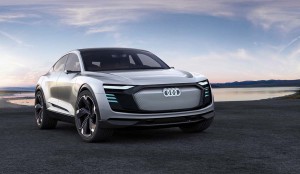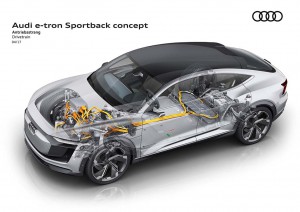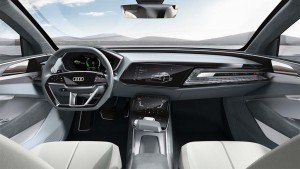As the Shanghai Motor Show gets underway, two trends dominate: growing consumer demand for SUVs and the government’s push for electrification.
Audi hopes to score on both counts with today’s debut of the eagerly awaited e-Tron Sportback concept. It’s the latest in a series of battery-electric show cars the German luxury maker has revealed over the last several years – and the closest yet to the production model now in the final stages of development.
“Following close on its heels, in 2019, comes the production version of the Audi E-Tron Sportback – an emotional coupé version that is thrillingly identifiable as an electric car at the very first glance,” said brand Chairman Rupert Stadler, during the Sportback concept’s Shanghai unveiling.
Set to level a direct assault on the Tesla Model X, the E-Tron Sportback is an Audi Q5-sized crossover-utility vehicle. But it adopts the same, fundamental skateboard-like architecture that has the lithium-ion battery pack mounted under the floor and the vehicle’s three motors on the front and rear axles. That layout delivers a far more roomy interior than a conventional, gas-powered vehicle, like the Q5, while also lowering the center of gravity – no small matter when you have a lot of batteries onboard.
In this case, that’s a full 95 kilowatt-hours of LIon cells, or only slightly less than the latest Tesla Model X P100d. Audi estimates they will deliver about 311 miles per charge, though that appears to be using the relatively lax European test cycle, which means we Americans can expect about 25% lower range once the production version of the Audi e-Tron Sportback arrives in the States.
(Strike could disrupt Tesla Model 3 launch. Click Here for the breaking story.)
Automakers continue to debate what’s the best way to drive their electrified vehicles. The Chevrolet Bolt EV, for example, has a single motor motivating the front axle. The Tesla offerings, as well as the Lucid Air, among others, put separate motors on each axle. The hybrid Acura NSX uses three motors: two up front, permitting electric torque vectoring, while the third motor and the twin-turbo V-6 dump power to the back wheels.
Audi also opts for a three motor layout and will torque vector, as well, but it has one motor up front on the e-Tron, two in back. They punch out a solid 496 horsepower and deliver roughly comparable launch performance to what you’d currently expect out of an SQ5, at 4.5 seconds 0 to 60 – though that will take twice as long as the blistering numbers the top-line Tesla Model X will deliver – a mere 2.3 seconds – in Ludicrous Mode.
The Audi look is readily apparent, with the concept Sportback clearly showing the influence of the marque’s new design chief, Mark Lichte. It features more sculpted body sides and hood, with broad, well-planted haunches intended to make clear you don’t confuse this battery-electric vehicle with the stodgy, first-generation EVs that were generally not all that much fun to drive. That impression is enhanced by the coupe-like roofline, as well as the 23-inch wheels.
Lichte’s take on the familiar Audi singleframe grille is eye-catching, with a fine mesh that is actually sealed, as there’s no engine to let breathe. A modest-sized intake under the grille provides air for the liquid-cooled battery pack and motors. The grille is framed by twin headlight slashes, LED lighting – including an illuminated version of the familiar Audi four-ring logo on the grille – emphasizes the e-Tron’s overall, futuristic appearance.
While this is one of the rare concept vehicles in recent memory not to be billed as “autonomous,” it appears Audi has that capability in mind. It says that some of the unique lighting on the Sportback can be used to communicate with other drivers and pedestrians, an issue of some importance if the person in the driver’s seat isn’t actually driving.
Some of the design elements of the Audi e-Tron Sportback Concept are unlikely to make the jump into production – notably the sideview cameras replacing traditional mirrors, though Tesla and several other automakers are petitioning U.S. regulators to allow the use of that wind-cheating technology.
Audi’s debut of the e-Tron Sportback follows this week’s unveiling of the Volkswagen I.D. Crozz Concept. It’s meant to signal what the sibling brand has in store for the near future, VW planning to deliver 30 different electrified vehicles by 2025, many of them bearing the new I.D. sub-brand badge.
(Click Here to check out VW’s Shanghai battery-SUV concept.)
The halls of the Shanghai Motor Show are filled with new electrified offerings from a range of domestic and international brands, though some manufacturers are clearly concerned about the pressure they are under from the Beijing government to migrate to zero-emissions technology. China is now the world’s largest market for plug-based products, though demand is still in the low single-digit range among all new car sales.
The good news is that “There are already about 150,000 charging stations in the country, with another 100,000 due to come on stream by the end of 2017,” said Dietmar Voggenreiter, Audi’s Board Member for Marketing and Sales. “We are well equipped for this rapid growth. In the next five years we will be offering five E-Tron models in China, including purely battery-powered vehicles with ranges well in excess of 500 kilometers (310.7 miles) such as the Audi E-Tron Sportback.”
Where the production model will debut remains to be seen. It could go back to Frankfurt this coming autumn, where the first concept version was revealed in 2015, or land in Beijing a year from now. But look for the Audi e-Tron Sportback to be on the road sometime late in 2018 as a 2019 model.
(Lexus reveals newly updated NX crossover in Shanghai. Click Here for a closer look.)




